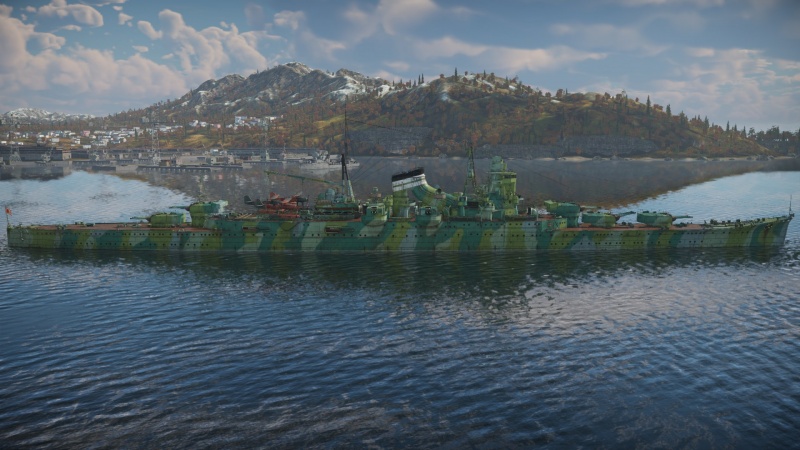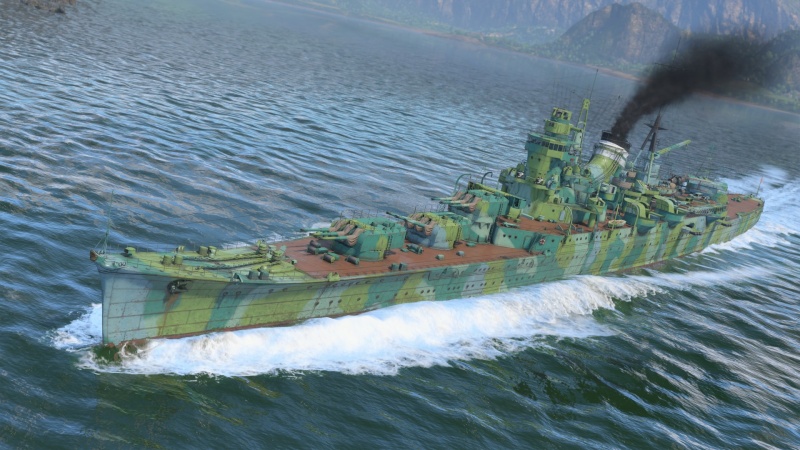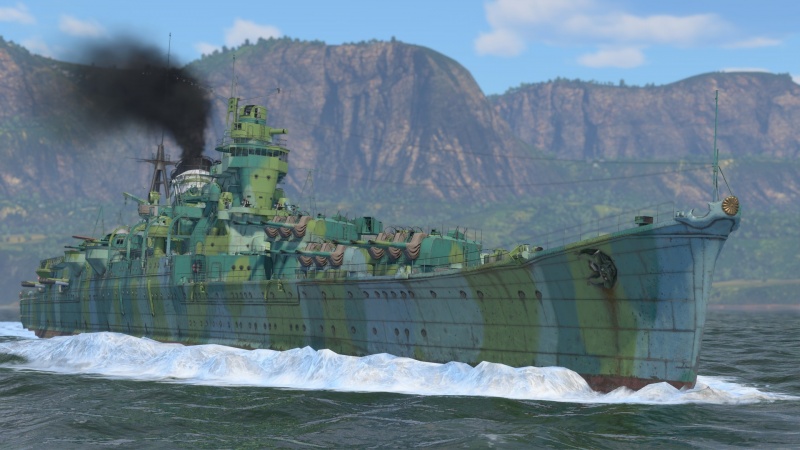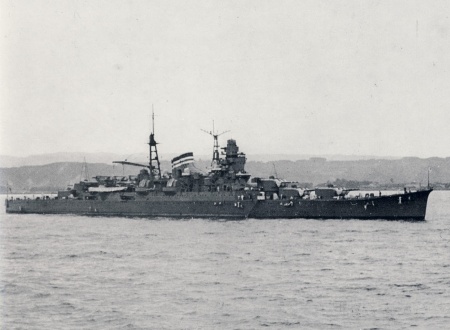IJN Mikuma
| This page is about the premium Japanese light cruiser IJN Mikuma. For other Mogami-class cruisers, see Mogami (Family). |
Contents
Description
The second of the Mogami-class cruisers, the Mikuma (三隈, namesake: Mikuma River) was designed as a heavy cruiser right from the start but, due to restrictions from the London Naval Treaty, the Imperial Japanese Navy mounted turrets with 155 mm guns in order to pass it off as a light cruiser. That the turrets were easy to remove and replace and that there were a number of 20 cm turrets lying around in storage that would perfectly fit into the ships was considered a convenient coincidence.
Mikuma was introduced in Update 1.97 "Viking Fury" purchasable in-game with Golden Eagles ![]() . It was included in a premium pack in March 2021, but it was removed from the store after the 9th Anniversary Sale. Compared to her tech-tree counterpart, the Suzuya, Mikuma's only two difference is that she features slightly more crew (958 vs. 918), and that she carries one less scout plane in her visual model (3 vs 4 on Suzuya), although only two can be launched from both ships. As the Mogami-class were built around high top speed and firepower, the Mikuma's lighter armaments result in improved mobility while having the same protection as her heavier-armed sister Mogami.
. It was included in a premium pack in March 2021, but it was removed from the store after the 9th Anniversary Sale. Compared to her tech-tree counterpart, the Suzuya, Mikuma's only two difference is that she features slightly more crew (958 vs. 918), and that she carries one less scout plane in her visual model (3 vs 4 on Suzuya), although only two can be launched from both ships. As the Mogami-class were built around high top speed and firepower, the Mikuma's lighter armaments result in improved mobility while having the same protection as her heavier-armed sister Mogami.
General info
Survivability and armour
Being essentially a heavy cruiser with light cruiser guns, the Mikuma is generally well-protected. Mikuma's citadel is protected with ~100 mm of RHA at the belt, 65 mm at the angled top, and 35 mm at the deck, which is strong enough to bounce several shots at longer range especially when angled. Her magazine, which sat on the waterline, is even better-protected with 140 mm at the belt and 40 mm at the deck. While most of her modest 951 crewmembers were packed inside her midship section, angling the ship will mitigate the issue and make them less vulnerable.
Unfortunately, since the Mikuma was designed with the emphasis on high offensive capabilities and good mobility, some compromises were required to achieve the goal. The Mikuma, as with the other IJN cruisers, has very poor turret and shell elevator protection. With a measly 25 mm of armour plate, Mikuma's guns can be easily disabled even by an average destroyer-calibre guns. Additionally, Mikuma's greatest strength of having numerous Type 93 "Long Lance" torpedoes at her disposal is also her greatest weakness as half of the 24 "Long Lance" are stored just nearby the torpedo tubes, essentially acting as an ammo racks that can be detonated and cause severe damage to the ship.
Mobility
Despite her massive size and displacement, the Mikuma is tied with her sister ship Suzuya and a smaller Isuzu as the second fastest cruiser in the game (after a much smaller "scout cruiser" Attilio Regolo) at 78 km/h (AB) or 67 km/h (RB). Owning to powerful 10 Kampon boilers powered four propeller shafts with 152,000 horsepower. With her high top speed, the Mikuma is capable of out-pacing almost every cruisers she will face and is able to closing in the gap at a faster rate.
However, due to the large size and displacement, the Mikuma is quite slow to decelerate and sluggish to handle at times. This can be detrimental, especially when it comes to dodging torpedoes and mines.
| Mobility Characteristics | |||
|---|---|---|---|
| Game Mode | Upgrade Status | Maximum Speed (km/h) | |
| Forward | Reverse | ||
| AB | |||
| Upgraded | |||
| RB/SB | |||
| Upgraded | |||
Modifications and economy
Armament
Primary armament
Mikuma's main armament consists of 15 x 155 mm/60 3rd Year Type cannons mounted in five triple turrets in A-B-Cs-X-Y setup. Due to the gun's setup, the Mikuma is able to deliver a full salvo at a steep 60 degrees angle, thus increasing the ship's protection effectiveness.
The 155 mm guns have three shell choice; a rudimentary HE shell with 3.39 kg of TNT equivalent, an APHEBC shell with high penetration (186 mm at 10 km) and a sizeable filler of 1.21 kg of TNT equivalent, and a HE-TF shell with the same filler as the HE shell, though is not useful due to the gun's slow reload and traverse. As with other similar guns, both shell has a high shell velocity at 920 m/s and thus were reasonably accurate at all ranges.
The guns have a rather mediocre rate of fire for its calibre at 6 RPM (10 second reload with ace crew) compared to other 150-155 mm guns with 7-8 RPM as baseline. This is made up with the sheer volume of rounds it can deliver for each salvo, with a well-aimed barrage capable of causing severe damage to the enemy ship.
| Penetration statistics | |||||||
|---|---|---|---|---|---|---|---|
| Ammunition | Type of warhead |
Penetration @ 0° Angle of Attack (mm) | |||||
| 1,000 m | 2,500 m | 5,000 m | 7,500 m | 10,000 m | 15,000 m | ||
| Type 0 HE | HE | 36 | 36 | 36 | 36 | 36 | 36 |
| Type 91 APHE | APHEBC | 313 | 269 | 210 | 165 | 131 | 93 |
| Type 0 HE | HE-TF | 36 | 36 | 36 | 36 | 36 | 36 |
| Shell details | ||||||||||||
|---|---|---|---|---|---|---|---|---|---|---|---|---|
| Ammunition | Type of warhead |
Velocity (m/s) |
Projectile mass (kg) |
Fuse delay (s) |
Fuse sensitivity (mm) |
Explosive mass (TNT equivalent) (kg) |
Ricochet | |||||
| 0% | 50% | 100% | ||||||||||
| Type 0 HE | HE | 920 | 55.79 | 0 | 0.1 | 3.39 | 79° | 80° | 81° | |||
| Type 91 APHE | APHEBC | 920 | 55.79 | 0.035 | 7 | 1.21 | 48° | 63° | 71° | |||
| Type 0 HE | HE-TF | 920 | 55.79 | 0 | 0.1 | 3.39 | 79° | 80° | 81° | |||
Secondary armament
Mikuma features 8 x 127 mm/40 Type 89 dual-purpose guns in four twin turrets placed around the funnel, which are reasonably effective against coastal boats and destroyers due to fast reload time. As with the main guns, it has two shell choices of a basic HE shell and a HE-TF shell with slightly higher filler but much better shell velocity (910 m/s).
Since Mikuma's dedicated anti-air weapons is quite weak, it is possible to use the 127 mm as a supplementary flak battery. Due to the HE-TF shell's high velocity, it can be surprisingly effective at longer ranges, though its performance gradually decreases as the enemy gets closer than 2 km.
| Penetration statistics | |||||||
|---|---|---|---|---|---|---|---|
| Ammunition | Type of warhead |
Penetration @ 0° Angle of Attack (mm) | |||||
| 1,000 m | 2,500 m | 5,000 m | 7,500 m | 10,000 m | 15,000 m | ||
| 127 mm HE | HE | 25 | 25 | 25 | 25 | 25 | 25 |
| 127 mm HE-TF | HE-TF | 25 | 25 | 25 | 25 | 25 | 25 |
| Shell details | ||||||||||||
|---|---|---|---|---|---|---|---|---|---|---|---|---|
| Ammunition | Type of warhead |
Velocity (m/s) |
Projectile mass (kg) |
Fuse delay (m) |
Fuse sensitivity (mm) |
Explosive mass (TNT equivalent) (kg) |
Ricochet | |||||
| 0% | 50% | 100% | ||||||||||
| 127 mm HE | HE | 720 | 23 | 0 | 0.1 | 1.96 | 79° | 80° | 81° | |||
| 127 mm HE-TF | HE-TF | 720 | 23 | 0 | 0.1 | 1.96 | 79° | 80° | 81° | |||
Anti-aircraft armament
The Mikuma's dedicated anti-air armaments consists of 8 x 25 mm Type 96 autocannons and 4 x 13.2 mm Type 93 machine guns, both placed in a twin mounts around the amidship. These AA armaments are quite light for her size and is largely useless beyond 2.5 km range, though it can works well in tandem with the secondary 127 mm guns, a skilled enemy pilot will be able to slip past the defence and attack the ship. Thus, it is always recommended to man the gun yourselves when the enemy gets too close.
Additional armament
The Mikuma features 24 x 610 mm Type 93 Model 1 Mod 2 "Long Lance" torpedoes launched from a pair of triple launchers on each sides of the seaplane catapults. Twelve were pre-loaded inside the launchers, while the other half were stored in ready racks near the launcher. With a large quantities of the dreaded "Long Lance" torpedoes, the Mikuma is capable of sinking several ships at longer ranges (including battleships) and capable of doing so multiple times (especially in Arcade). Although the launchers have a restricted arc and requires showing full broadsides to the enemy, exposing the ship to damage in the process.
However, since the Mikuma is already packed with several heavy weapons, Japanese engineer were unable to put the extra "Long Lance" storages at a safer place. As mentioned in the "Survivability and armour" section, these extra torpedoes are essentially external ammo racks that can be detonated and is detrimental to Mikuma's survival. Thus, it is recommended to unload these torpedoes when playing in a map where torpedoes are less useful, such as maps with numerous islets and covers.
Scout plane
Located amidships are two catapults carrying one E7K2 scout plane each (the E7K2 stored on the trolley is not available) which provides unique offensive and defensive abilities, expanding tactical options. Ship-launched scout planes fly just like regular tree units but lack munition choices and cockpit views. The E7K2 is equipped with only defensive machine gun turrets (ventral as well as dorsal) and carries 4 x 60 kg bombs. It also has the scout plane ability to cap zones and lay down smoke cover (up to 3 times). Captains will be wise to remember to utilize the aircraft and consider when best to use it, for example to cap a point early or late in the match, to create a smoke screen to stymie enemy bombardment and repair, to attack enemy units directly, or perhaps something completely new! Carrying a heavier bomb load than most other scout planes, this unit has a very good chance to sink enemy boats or even a destroyer.
Usage in battles
With a combination of strong protection, large number of 155 mm guns, high top speed, and large amounts of Long Lance torpedoes, the Mikuma is highly versatile in terms of playstyle. The ship is capable to act as a spearhead by getting close to the enemy using its fast top speed and deal high burst damage to quickly dispatch enemy ship, or staying behind as a support and dealing damage using its guns and large number of torpedoes. However, the Mikuma does still suffer from a common weakness of Japanese cruisers, namely the poorly-protected turrets and lacklustre anti-air defence.
A common mistake made by many "heavy light cruiser" players is to venture too deep into the enemy territory due to their fast speed and heavy protection also applies with the Mikuma. To prevent from overextending and exposing yourself as a target in the process, situational awareness is key. Always look at the minimap to make sure you're not getting to close to the enemy, and make sure to find a way to retreat before others notice you. Knowing the type of enemy ships you face is also beneficial as the Mikuma has a high burst damage potential, and knowing where to shoot can also help destroy the enemy faster.
- Enemies worth noting
- Brooklyn-class - While these US light cruisers are similar to the Mikuma in terms of main armament (15 x 152 mm guns), the Brooklyns are more specialized in gunnery compared to the Mikuma, with them sacrificing speed and torpedoes for absurd rate of fire of up to 10 rounds per minute (with an aced crew). The results of a 1-vs-1 fight between both ships were thus often depending on who managed to deal a crippling damage against the other's main turrets first. Mikuma's paper-thin turrets can be easily disabled by a few accurate salvoes, while Brooklyn's has a large magazine sitting way above the waterline that can cause devastating damage if it detonates.
Pros and cons
Pros:
- High top speed for such a large ship (78 (AB)/67 km/h (RB))
- Features the same hull as the Mogami heavy cruiser; able to withstand a fair amount of enemy fire before sinking
- Numerous powerful 155 mm guns (5 turrets with 3 guns each, 15 in total) with good coverage
- 24 Long Lance torpedoes which have the capability to heavily damage battleships and wreck everything else
- Two scout planes
Cons:
- Poorly-protected main turrets and elevators, very easy to get disabled
- Mediocre anti-air defense, especially at closer ranges
- Wide hull makes evading enemy torpedoes difficult as it takes some time to manoeuvre the ship
- External Long Lance torpedo storages can be detonated when being hit
- Torpedo arcs are limited, have to show almost full broadside to launch torpedoes
- The 155 mm guns lack the penetration and damage performance to reliably combat battleships or heavy cruisers Mikuma will face often
- The importance of torpedoes makes Mikuma very map dependent: torpedoes are harder to use on maps with lots of cover, greatly reducing the potential of its most potent weapon
History
IJN Mikuma was a ship of the Mogami class of light cruisers, built for the Imperial Japanese Navy (IJN) during the interwar period. Designed to be converted into heavy cruisers later on, they were the largest and most heavily-armed cruisers ever built until the introduction of the American Brooklyn-class several years later. Mikuma was commissioned in 1935, and converted into a heavy cruiser just before the outbreak of the Second World War. She saw action during the Battle of Sunda strait as well as the Battle of Midway; she was sunk during the latter battle when attacked by American carrier aircraft.
Design and development
Mikuma was the second of four Mogami-class cruisers. To comply with the Washington Naval Treaty, she was initially classified as a light cruiser with an official displacement of 8,500 tons. However, she was designed from the outset to be refitted with 8-inch (203 mm) guns and made into a heavy cruiser in a later refit. Her main armament consisted of fifteen 6-inch (152 mm) guns in five triple turrets, giving her one of the heaviest broadsides of any Treaty cruiser. She was also fitted with moderate anti-aircraft protection and four triple torpedo tube launchers carrying the deadly Type 93 "Long Lance" torpedoes.
Mikuma's relatively heavy armour and large armament placed extensive strain on the 10,000-ton limit that she was built to comply with. In fact, a British Admiral once quipped that "[The Japanese] are either lying to us or building [the Mogamis] out of cardboard." Indeed, the low displacement gave the Mikuma relatively weak stability, which was improved later on through the addition of large bulges on the sides of the hull. Mikuma was initially launched in 1935, but didn't see active service before the Second World War to enable Japanese engineers to install her bulges and replace her original 6-inch main armament with an improved 6-inch main battery.
Operational history
After her commissioning, Mikuma was dry docked once again to receive her revised 8-inch main armament; her 6-inch turrets were given to the battleship Yamato. Prior to the start of the Pacific War, Mikuma participated in the occupation of the Indochina area by Japanese forces. Assigned to Cruiser Division 7, she was still in the Southeast Asian theatre at the time of the Pearl Harbour attacks of December 1941.
After the Pearl Harbour attacks, Mikuma covered the invasion of British Borneo. There, she encountered an enemy force attacking Japanese landing personnel, composed of the American cruiser USS Houston and Australian cruiser HMAS Perth. Along with her escorting destroyers and sister ship Mogami, the Japanese force was able to destroy both cruisers quickly. Mikuma herself emerged relatively unscathed, and spent the latter part of early 1942 attacking shipping in the Southeast Asian area.
In June of 1942, Mikuma was one of the escort ships tasked with escorting the Japanese Carrier fleet on the attack on Midway Atoll. However, as they had left later than the rest of the fleet, they lagged behind and the order was given for them to slow down and proceed at a leisurely speed. However, the order was received late, and Mikuma, along with her sister ships Suzuya, Kumano and Mogami, was already within 90 kilometres of Midway atoll. They were spotted by an American submarine, and due to some communication errors, she was rammed by the Mogami. The two ships ended up stuck to each other, and the Japanese crews worked frantically to resolve the collision.
During this time, the two cruisers were attacked by a flight of B-17s from Midway that failed to score any hits. Finally, the ships were unstuck, and Mikuma was headed towards Wake Island when the pair of cruisers were attacked by 31 SBD Dauntless dive-bomber aircraft from the USS Enterprise. Mogami was hit by six bombs that caused severe damage, but managed to limp home. Mikuma was less lucky, having been hit extensively on her forecastle and superstructure by 5 American bombs. Eventually, the fires caused by the bombs caused her torpedoes to explode; this doomed the ship. As a result, the Mikuma was abandoned, and eventually capsized and sank.
Media
- Skins
See also
Links to articles on the War Thunder Wiki that you think will be useful for the reader, for example:
- reference to the series of the ship;
- links to approximate analogues of other nations and research trees.
External links
References
- Budge, K. (2007). Mogami Class, Japanese Heavy Cruisers. Retrieved January 12, 2021, from http://pwencycl.kgbudge.com/M/o/Mogami_class.htm
- Chen, P. C. (2004). Heavy Cruiser Pensacola. Retrieved January 12, 2021, from https://ww2db.com/ship_spec.php?ship_id=39
- Hackett, B., & Kingsepp, S. (1997). IJN Mikuma: Tabular Record of Movement. Retrieved January 12, 2021, from http://www.combinedfleet.com/mikuma_t.htm
| Mitsubishi Shipbuilding Company Ltd. | |
|---|---|
| Light Cruisers (CL) | |
| Kuma-class | IJN Tama |
| Sendai-class | IJN Sendai |
| Mogami-class | IJN Mikuma |
| Heavy Cruisers (CA) | |
| Furutaka-class | IJN Furutaka |
| Aoba-class | IJN Aoba |
| Myōkō-class | IJN Haguro |
| Tone-class | IJN Tone |
| Battleships (BB) | |
| Ise-class | IJN Hyuga |
| See also | Mitsubishi Heavy Industries, Ltd. (Post-War) |
| Japan light cruisers | |
|---|---|
| Kuma-class | IJN Tama |
| IJN Yubari* | |
| Nagara-class | IJN Isuzu |
| Sendai-class | IJN Sendai |
| Agano-class | IJN Agano |
| Mogami-class | IJN Mikuma · IJN Suzuya |
| * Unique ship | |
| Japan premium ships | |
|---|---|
| Motor torpedo boats | Type T-14 (mod. 1) · Type T-51a |
| Motor gun boats | Type 4 (Mod 4) · PG 02 |
| Sub-chasers | Type K-8 No.13 |
| Frigates | Akebono |
| Destroyers | IJN Satsuki · IJN Nenohi · IJN Hayanami · IJN Kiyoshimo · IJN Yuudachi · JDS Yūgure (DD-184) |
| Light cruisers | IJN Yubari · IJN Mikuma |
| Heavy cruisers | IJN Myoko |
| Battleships | IJN Yamashiro |









